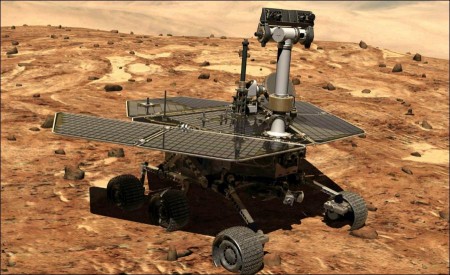NASA scientists find evidence suggesting salty water may flow on the planet’s slopes.
Scientists have found evidence of flowing salt water on steep Martian slopes, which if confirmed would be the first discovery of active liquid water on the red planet, NASA has said.
The data gathered by the Mars Reconnaissance Orbiter has given new focus to the hunt for life forms and scientists hope that in the coming years lab experiments and new space missions may shed more light on what they have seen.
“We have found repeated and predictable evidence suggesting water flowing on Mars,” Michael Meyer, lead scientist for the Mars Exploration program, told reporters.
The US space agency said the orbiter circling Mars since 2006 had monitored numerous instances of what appeared to be water flows occurring in several locations during the Martian spring and summer.
Time-sequence imagery of the Newton crater in the southern mid-latitude region showed finger-like markings spreading along several steep slopes and then fading again once colder temperatures move in.
“The best explanation we have for these observations so far is flow of briny water, although this study does not prove that,” said Alfred McEwen of the University of Arizona’s Lunar and Planetary Laboratory.
“It’s a mystery now, but I think it’s a solvable mystery with further observations and experiments,” said McEwen, lead author of a study explaining the findings in the journal Science.
No liquid water has been found on Mars, though ice has been discovered at the poles. All life forms need water to survive, so the existence of a water source could point to a haven for primitive life.
“I really think this is a very exciting discovery because it is our first chance to see an environment on Mars that might allow for the expression of an active biological process if there is present day life on Mars,” said Lisa Pratt, professor of geological sciences at Indiana University.
“The next big question is to try to understand the origin and the source of these flows… (and) whether or not they may provide a conduit or a connectivity to a larger deeper brine pool or if in fact these fluids are just isolated patches or pockets.”
McEwen, principal investigator for the orbiter’s High Resolution Imaging Science Experiment (HiRISE) that captured the images, said the orbiter recorded “thousands” of the flows over the past three years at seven locations. It had identified 20 other possible sites of similar flows, he said.
McEwen cautioned that the water flows remained “circumstantial,” and said scientists “lack that direct confirmation of water” from other instruments studying the planet, but hope it will be confirmed in future missions and lab experiments.
In any case, it does not appear that scientists are seeing anything akin to a gushing river on Mars, but more likely a subterranean movement.
“The flows are not dark because of being wet,” McEwen said. “They are dark for some other reason,” possibly because the briny water runs below the surface and is altering the land’s appearance in a way that makes it look dark.
“By comparison with Earth, it’s hard to imagine they are formed by anything other than fluid seeping down slopes,” said Mars Reconnaissance Orbiter project scientist Richard Zurek of NASA’s Jet Propulsion Laboratory. “The question is whether this is happening on Mars and, if so, why just in these particular places.”
Frozen water has been detected in some of Mars’s higher latitudes, and other evidence has suggested that water interacted with the Martian surface throughout the planet’s history.
NASA has placed a renewed focus on Mars, with the 30-year space shuttle program now over and efforts under way to build a spacecraft capable of carrying humans to the red planet by 2030.
The space agency’s unmanned Curiosity rover, also known as the Mars Science Laboratory, is due to explore a mountain inside the Gale Crater on Mars that should reveal whether signs of life ever existed on the red planet.
The largest US rover ever, built at a cost of $2.5 billion dollars, it is set to launch later this year and land in August 2012.
However, the area it will explore is far from the briny water slopes, so Curiosity is not expected to be able to confirm the latest findings.
Visits: 73



